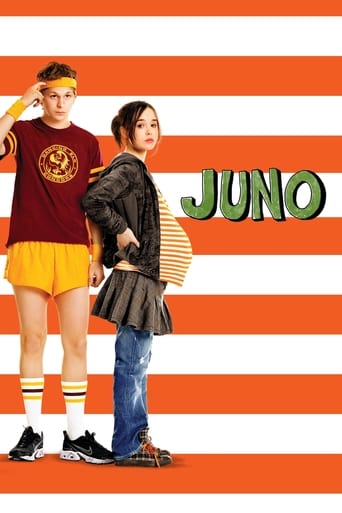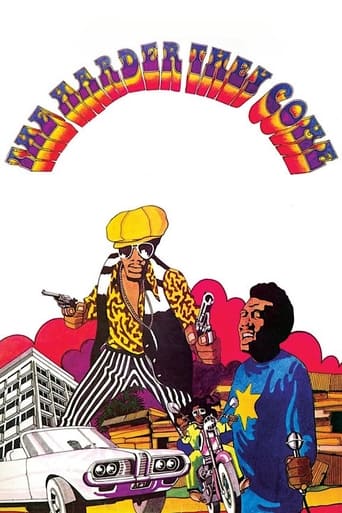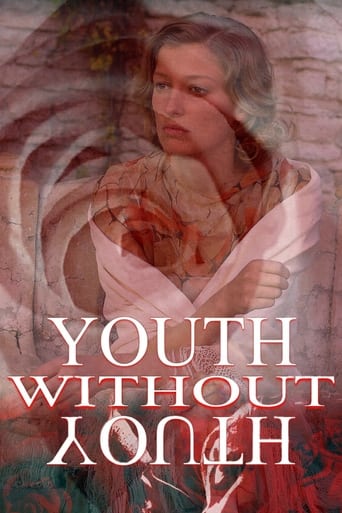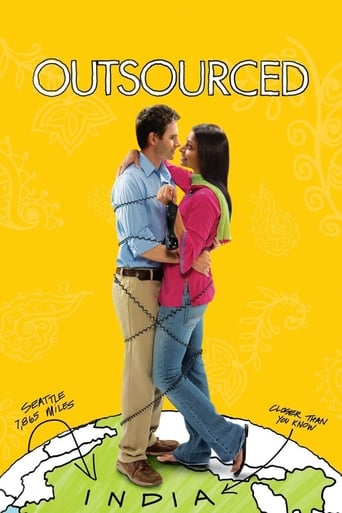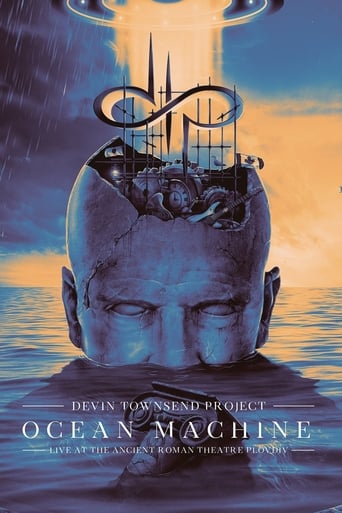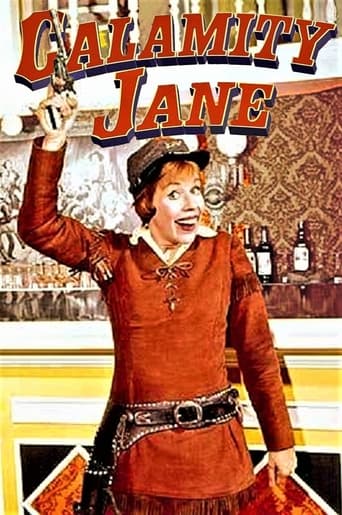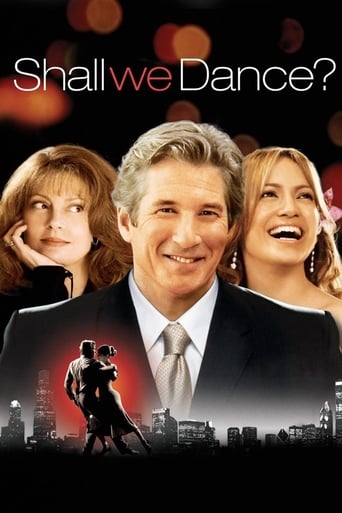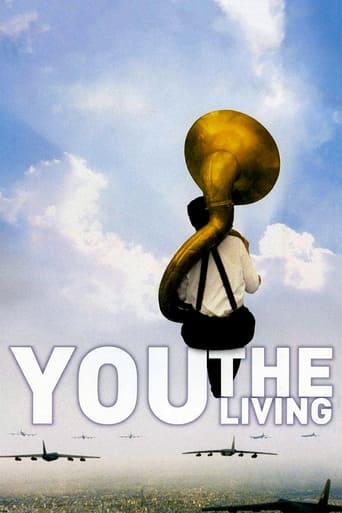
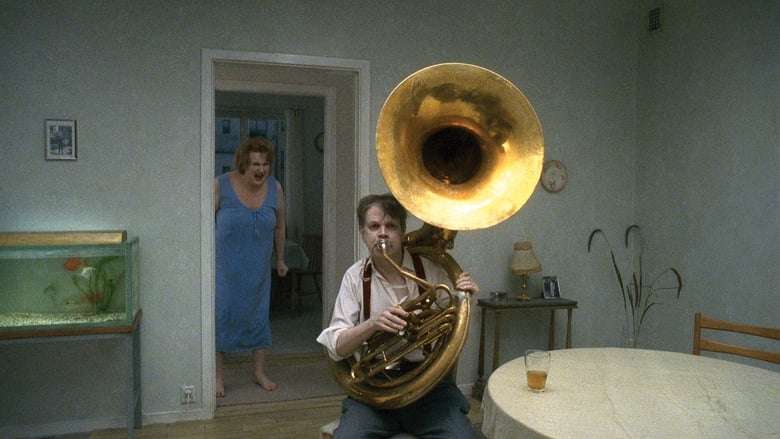
You, the Living (2009)
In the Swedish city of Lethe, people from different walks of life take part in a series of short, deadpan vignettes that rush past. Some are just seconds long, none longer than a couple of minutes. A young woman (Jessica Lundberg) remembers a fantasy honeymoon with a rock guitarist. A man awakes from a dream about bomber planes. A businessman boasts about success while being robbed by a pickpocket and so on. The absurdist collection is accompanied by Dixieland jazz and similar music.
Watch Trailer
Cast



Similar titles
Reviews
How best to describe about Roy Andersson's quirky art-house satire about everyday life, titled You, The Living (2007)? To begin with, I had a lot of mixed thoughts seeing this film throughout the entire time because I felt that each episode almost had no real plot and sometimes whether it was humorous or depressing but can be both at the same time. Each episode had different characters dealing with life but also had reprising roles in the next one or so, the main focus was just on these people and as their daily lives unfold in comical or tragic ways so it is easy to tell the whole film is just that. What about the title itself? Perhaps I may never know why it was so called You, The Living. More importantly, the film is well shot & well edited as for its acting by the cast and there are simply no spoilers since each episode doesn't have a real plot (as mentioned) but could take a few multiple viewings after first time seeing it. Frankly, the art & humor of the film do make a good blend for some of today's art-house comedies - ones that is hard to tell yet just simply sit & enjoy. Besides, this marks my first time seeing the works of Andersson as well. Not a bad start, it could need little more understanding the concept when seeing it time to time afterwards.My Rating: 4/5
I've been wracking my brain to figure out a good comparison in popular media to Roy Andersson's dark comedy You, the Living or Du Levande (2007). The best parallel I can draw is to Tom Wilson's comic strip Ziggy. If you are familiar with the comic, it revolves around a rather mundane little man, Ziggy, who always winds up being the butt of his own jokes. Luckily, Wilson's comic only appears once a week and is four short newspaper frames at most. You, the Living sadly perseveres for an hour and a half.The film is made up of dozens of vignettes. Some are very brief glimpses while others last uncomfortably too long. Almost every scene is taken in a single shot with a wide angle, with the camera positioned in one spot. Occasionally there are slow zooms, or pans that shift so slowly that the viewer is unsure whether the camera is actually moving or if they are just becoming drowsy from staring so long at an unchanging scene. I have never seen anything filmed like this before, with so few shots and perspectives. Most filmmakers try to engage the audience with diverse composition; this felt more like I was watching a play because of the static angle. It also had a theatrical quality because of the set. I found the set to be very pleasing to the eye. It reminded me a lot of Wes Anderson's films because everything in it seemed very deliberate, like it was in exactly the right place. This contrasted with the subject matter; the majority of characters were disheveled and were going through existential crises. They seemed not to belong to the pristine world of this elaborately constructed set. Many of the vignettes began with a character breaking the fourth wall and addressing the viewer, "Last night I had a dream," and the set successfully created the dreamy quality that many of the characters described. Andersson used colors that were very bright, vibrant shades and vibrant, but they were all washed out shades and seemed to be watered down. The fact that this film took place in contemporary time in an urban setting (an imitation of Stockholm) but all of the scenery was designed also added to the dreamy quality in which you know that you are in a specific place but it is different for some reason than the way you know it in reality.Though it was aesthetically well put together, when it comes down to it, I think this is a film that you'll either love or hate. I happened to hate it. It had aspects of the absurd in which there were scenes that could certainly happen, but they never actually would because they are far out. All of the characters were caricatures whose actions were disgruntling. They found themselves in awkward situations which were laughable and pathetic. It was like Family Guy because it was so stupid that I felt bad laughing, though that is not the strongest comparison because that humor is slapstick, whereas Andersson makes you cringe and chuckle at other people's misery. Usually, what began as humorous lasted half a minute too long, leaving me as a viewer anticipating the next bizarre event, tapping feet hoping to escape the current misery. Andersson admits that he has an expressionist influence, which I saw come through in this piece. The film was not so much plot driven as theme driven. It never focused on one character for too long but would switch between characters whose lives vaguely intersected. If any take away from You, the Living it would be, "when something is bad, it can only get worse." In one of the early scenes, a man is practicing the tuba in his apartment. It cuts to the man in the apartment below, frustrated with the noise bleeding through the ceiling. He bangs a broom against the ceiling to signal the tuba player to stop, but his broom banging ends up knocking down his chandelier. This pretty much sums up the "heads you win, tails I lose" motif. You don't get to really learn any intricacies of the characters. Instead they are all seen as one dimensional and are defined by a certain type of action rather than as multi-faceted. There is no passion for any of them, and ultimately, you don't really care that they are in miserable predicaments because none of them have depth. This is ultimately a very bleak film and even if you find it more amusing than I did, it will likely still leave you disheartened.
Roy Andersson has become known for his deadpan, surrealist, and often-dark humor. You, the living is a great example of that. It deals with the lives of ordinary strange people with no real connections until you look closer and notice the details. For me, that is what makes this movie funny, sad, and artistically impressive. Andersson is known for tending to use unprofessional actors in his film, which add to both the realness of the reality he has created and the offsetting surrealist feel of the film. Thought You, the Living, Andersson has the actors monologue about their lives (often breaking the fourth wall) with whatever grievance or happiness is afflicting them. One woman (in a very famous scene) reflects on a dream she had in which she married her crush. Another woman cries as her class watches because her husband called her a name. The acting is atrocious, but the sets are absolutely incredible, so that there is a strange disconnect between the actors and their surroundings. At the same time, their slightly off looks, pale dead-like faces match the sad, dreary, sterile feeling of the environment they are placed. The humor in this film tends to be completely oblivious to the characters, which is a sad commentary on the reality we find ourselves in. A great example from the film is the very sweet looking man who is practicing his drums. He is alone in a very simple room listening to music while keeping beat with his drum, which has been muffed. Partway through the scene, the door shuts behind him in a seemingly angry way, while the man notices, does not seem bothered and continues to play. Another example is when a man is recalling a dream he had while slowly passing the camera in his car (he is stuck in traffic) The entire dream is emotionless for him until the very end when he has the realization that the electric chair is a terrible invention.Andersson uses steady, long shots to capture this humor. Because of this, he has created a style that is entirely his own with no imitators or followers. This is partly because the shots and construction of the set are so detailed that other directors cannot possibly think of doing it in this way because it is so time (and money) consuming. When the woman talks about marring the guitarist. Andersson built that large set on a functional rail so it could be moved around and leave at the end of the scene. While digitally altering the film may have been more feasible, knowing how much work went into that one scene is incredible and makes watching it again, that much more impressive. In this sense I can really see the artistry in this film, even if I did not particularly enjoy watching it, I can appreciate the effort, time, and thought that went into each scene.For all its humor and incredible artistry, the overall message of the film is rather sad and depressing. Andersson tears about the way we think we fit into this world with his mockery of our feeble attempts to be something special. He even troughs the title in our face with a bit of sarcasm and perhaps contempt, You, the Living. With the sad monotonous way we live our life and pointing out the humiliation of our existence. Though Andersson has been critiqued for his seemingly blaming stance of society, he says he does it with a sad heart, and that his films are not meant to anger, but are done with understanding and sadness.You, the Living is supposed to be the second in a trilogy of films, the first being Songs from the Second Floor. His next and third film for this series is anticipated to come out soon. What I find interesting, is with his great success of his first movie, A Swedish Love Story, he was depressed about being pegged for a certain type of style and refused to make a sequel. After years of work (not with feature films) he has finally been pegged down to a style, but it entirely his own and of his own making. In today's world, even with a relatively new industry like film, that originality and creativity is what I find most impressive; especially with his work in You, the Living.
"I had a dream last night..." This repeated line sets the tone and much of the plot for Roy Andersson's film You, the Living. You, the Living is a film that gives the viewer a few scenes of a number of people's lives and gives them the opportunity to see what the characters had dreamed the night before. These characters live very mundane and repetitive lives and the movie goer is given an opportunity to see into their more fantastical imaginings about what their life could be like. This non-linear story progresses through a series of glimpses into the everyday lives of a number of characters – some who turn out to be connected to each other and others who do not. The repetition of the music of the 'New Orleans' jazz band and the phrase "I had a dream last night" are the strongest connections that the viewer can make to understand the story. Roy Andersson seems to be taking a study of the everyday realities of human life and the mundane repetition that compromises so much of it. Andersson is able to manipulate these realities by looking into the dreaming minds of his characters, and showing what their dreams from the previous night actually looked like – playing them out as if they were a part of reality. The audience gets to see everything from a man put to death for breaking antique china – to a young woman marrying a rock star and the awesome times they have together. These dreams are completely absurd but played out as if they were completely realistic. Overall it is an interesting story that attempts to look at reality and absurdity together.I think that the different dreams that Andersson (and the writers) have chosen for their characters to have and for the audience to see are very interesting and completely opposite of each other in every way. On the one hand we have the dream of broken china and the death penalty. If I were a psychologist I'm sure that I could have a field day with all the dreams in this movie, but the first one seems to have the most blatant symbolism of fear about public performance and a fear of death. I adore how this man is overwhelmed by this feeling that he must be the entertainment at a sad dinner wake and the way that his dream plays out. Andersson is brilliant in the extremely careful setup as he exams the different pieces of china and the different sides of the table cloth – only to have all his worst fears come true when the china comes flying off with the table cloth. We then move on to the masterfully absurd court scene in which this poor, scared out of his wits gentleman is sentenced to death for his awful crime of destroying antique china.Andersson uses absurdism to point out a lot of the more quirky aspects of our everyday lives that we may just not be paying attention to. He contrasts the daily call for last drinks at the local bar with a young woman's dream of her life as it would be married to a rock star. By using so many extremes in the film Andersson is able to get at the quintessential idea that life can be mundane and repetitious if we allow it to be, but if we dream big dreams and try to pursue bigger things, our lives can be more than just the daily grind we live through every day.While I found this film difficult to follow at times, and slightly confusing in the formatting – with periods of very little dialogue and seemingly unconnected actions, in a close viewing I really enjoyed the overall message of the film. I found the filming style of Andersson to be very interesting and it is clear that he is a real masterful filmmaker. He was able to connect a group of seemingly unconnected scenes in an interesting and entertaining way. I think that this is the type of film that only gets more compelling and interesting as you view it multiple times. As you continue to understand the connections of the characters and how their dreams fit into the realities that they live you are able to see how compelling the story of everyday life can be especially when you look at the dreams that go with it. Overall I recommend this film if you are willing to dedicate yourself to the multiple viewings it takes to truly appreciate it.




